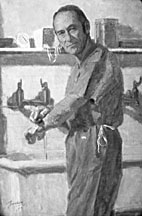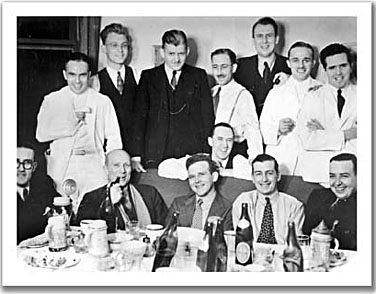|
3
|
THEODORE BROWN RASMUSSEN (1910-2002)
Surgeon, Scientist, Teacher and Friend
By Dr. William Feindel, oc, goq, mdcm
Portrait of Theodore Rasmussen
by Lynn Buckham, 1974
|
 |
|
Family and Education |
|
Theodore
Brown Rasmussen was born on 28th April 1910 in
Provo, Utah, the son of Gertrude Brown and Andrew Theodore
Rasmussen1. His father became Professor of
Neuroanatomy at the University of Minnesota from which Dr
Rasmussen later graduated with a BS, MB, 1934; MD, 1935; MSci in
Neurology, 1939. He supported himself through medical school by
playing clarinet and saxophone in a jazz band. Because of his
keen interest in track and field sports he arranged a general
surgical internship in New York so he could attend these events
at Madison Square Garden. He then continued on the neurosurgical
service at King's County Hospital in Brooklyn for two years with
Dr Jefferson Browder, a trainee of Harvey Cushing. Browder had
developed one of the best centers for the treatment of head
injuries in the United States. Young Rasmussen decided on a
career in this specialty. On the advice of Dr Owen Wangensteen
he spent six months at the Montreal Neurological Institute, but
then followed Dr Wilder Penfield's suggestion to do a fellowship
in neurology for three years at the Mayo Foundation. He returned
to the MNI from 1939 to 1942 for his neurosurgical training
under Wilder Penfield, William Cone and Arthur Elvidge.
|
|
 Group of MNI fellows and staff with Dr Penfield. Dr Rasmussen can be
seen
Group of MNI fellows and staff with Dr Penfield. Dr Rasmussen can be
seen
(2nd on left) in the center of the group, with arms on the
sofa.(circa 1939) |
Military Service
Eight months short of completing his senior
residency, he was called up for the United States Army. He spent the
next four years as Chief of the Neurological Section in the
14th Evacuation Hospital in the
India-Burma theater of operations on the Ledo Road. He
was discharged with the rank of Lieutenant-Colonel. During
that time he treated a series of a hundred patients with
causalgia by sympathectomy and recorded these case studies with
a colleague in the Journal of Neurosurgery.
1 Many years later, a neurosurgical
colleague earnestly queried, "Ted, how come you
were born in such an out-of-the-way place as Provo?" Ted succinctly replied, "I wanted
to be near my mother." |
|
|